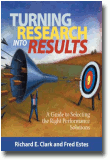
Turning Research Into Results
A Guide to Selecting the Right Performance Solutions
By:
Richard E. Clark, University of Southern California
Fred Estes
Published 2008
This book presents solid, current research that forms the basis for ways to “engineer” maximum performance and ways to select products that reflect the best research and evaluation. The authors have drawn on “what is known” from only the most important research findings and solid evaluation studies. This research lays the foundation on which to build a solid framework for improving performance and organizational effectiveness and forms the basis for recommendations. A reference section provides the sources for those wishing to dig deeper into the research. A secondary aim of the book is to describe, “what is known to be unknown” about ways to enhance peoples work performance. This area marks the frontier of knowledge—a land of both risk and opportunity. There is risk because our knowledge in this area is incomplete or inadequately tested. Yet there is opportunity here to learn more and contribute to knowledge. As in the Old West of the American frontier, where the pioneers precede the mapmakers and engineers, practitioners in organizations must work daily with problems where the state of knowledge is incomplete. The book attempts to post signs at these performance improvement frontiers. A review of this book by Dr. Brenda Sugrue (currently Director of Instructional Systems for Ford Motor Company—formerly a training manager for IBM and a former professor at the University of Iowa) described it in the following way:
This book is all you need to understand the process of performance improvement in organizations, and the “active ingredients” that impact performance. The book separates the snake oil and fads from solutions that are supported by research. It gives clear and researchbased guidelines for diagnosing the causes of performance gaps and selecting solutions for knowledge, motivation, and organizational problems. Case studies illustrate the application of the model and rules. In addition, the book describes how to reliably and validly evaluate the effects of performance solutions and identifies flaws in some common approaches to evaluation. The book answers the kinds of “why” and “what if ” questions that rarely get addressed. It includes a powerful model of motivated performance that can be used to address any motivational problems. (It provides the reader with) the arguments and references to support organizational development and training practices and also the arguments and evidence to abandon practices that have been shown to either be ineffective or to do more harm than good. If you want to understand why what you are doing works (or doesn’t work), you need to read this book. It is unlike any other to date in the field of performance improvement and training. It takes the profession to a higher level and is a must for anyone working in the area of organizational development, performance improvement, or training.
-
Paperback978-1-59311-991-1
Web price: $45.04 (Reg. 52.99)

-
 (Re)Envisioning Social Studies Education Research
Current Epistemological and Methodological Expansions, Deconstructions, and Creations
(Re)Envisioning Social Studies Education Research
Current Epistemological and Methodological Expansions, Deconstructions, and Creations
-
 American Educational History Journal - Golden Anniversary Edition
Volume 50 Numbers 1 & 2
American Educational History Journal - Golden Anniversary Edition
Volume 50 Numbers 1 & 2
-
 Distance Learning
Volume 20 #3
Distance Learning
Volume 20 #3
-
 Distance Learning
Volume 20 #4
Distance Learning
Volume 20 #4
-
 Faculty Development
Achieving Change Through Action Research
Faculty Development
Achieving Change Through Action Research
-
 Qualitative Research With Diverse and Underserved Communities
Qualitative Research With Diverse and Underserved Communities
-
 Quarterly Review of Distance Education
Volume 24 #1
Quarterly Review of Distance Education
Volume 24 #1
